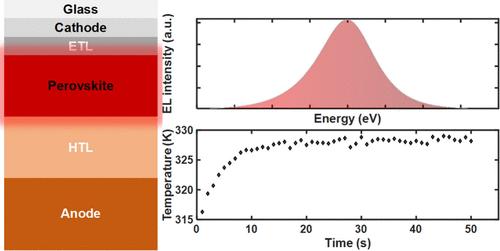钙钛矿led的电致发光温度表征
IF 9.1
1区 材料科学
Q1 CHEMISTRY, MULTIDISCIPLINARY
引用次数: 0
摘要
尽管钙钛矿发光二极管(PeLEDs)进展迅速,但实现高稳定性仍然是一个突出的挑战。发光二极管在工作过程中产生热量,提高温度,加速器件退化。为了确定PeLED温度,采用了以红外热成像(ITI)为代表的非常有限的技术。然而,ITI主要表征器件暴露的上表面的温度,而没有解决钙钛矿发射层中的实际温度。在这里,我们通过电致发光(EL)分析直接表征钙钛矿层的温度来解决这一挑战。测试了在近红外(FAPbI3)、红色(FA0.5Cs0.5PbI2Br)和绿色(FA0.6Cs0.7PbBr3)光谱区域发射的pled模型。从EL光谱中获得了与热展宽相关的乌尔巴赫能量,实现了工作条件下钙钛矿发射层温度的实时跟踪。我们的结果表明,电致发光分析是一种简单有效的方法来表征等离子体的工作温度。本文章由计算机程序翻译,如有差异,请以英文原文为准。

Temperature Characterization of Perovskite LEDs by Electroluminescence
Despite the rapid progress in perovskite light-emitting diodes (PeLEDs), achieving high stability remains an outstanding challenge. PeLEDs produce heat during operation, raising the temperatures, which accelerate device degradation. To determine the PeLED temperatures, a very limited number of techniques represented by infrared thermal imaging (ITI) are employed. However, ITI mainly characterizes the temperature of the exposed top surface of the device, leaving the actual temperature in the perovskite emissive layer unresolved. Here, we address this challenge by directly characterizing the temperature of the perovskite layer via an electroluminescence (EL) analysis. Model PeLEDs emitting in the near-infrared (FAPbI3), red (FA0.5Cs0.5PbI2Br) and green (FA0.6Cs0.7PbBr3) spectral regions are tested. Urbach energies related to thermal broadening are obtained from the EL spectra, enabling real-time tracking of the perovskite emissive layer temperature under working conditions. Our results demonstrate that the EL analysis is a simple and effective method for the operando temperature characterization of PeLEDs.
求助全文
通过发布文献求助,成功后即可免费获取论文全文。
去求助
来源期刊

Nano Letters
工程技术-材料科学:综合
CiteScore
16.80
自引率
2.80%
发文量
1182
审稿时长
1.4 months
期刊介绍:
Nano Letters serves as a dynamic platform for promptly disseminating original results in fundamental, applied, and emerging research across all facets of nanoscience and nanotechnology. A pivotal criterion for inclusion within Nano Letters is the convergence of at least two different areas or disciplines, ensuring a rich interdisciplinary scope. The journal is dedicated to fostering exploration in diverse areas, including:
- Experimental and theoretical findings on physical, chemical, and biological phenomena at the nanoscale
- Synthesis, characterization, and processing of organic, inorganic, polymer, and hybrid nanomaterials through physical, chemical, and biological methodologies
- Modeling and simulation of synthetic, assembly, and interaction processes
- Realization of integrated nanostructures and nano-engineered devices exhibiting advanced performance
- Applications of nanoscale materials in living and environmental systems
Nano Letters is committed to advancing and showcasing groundbreaking research that intersects various domains, fostering innovation and collaboration in the ever-evolving field of nanoscience and nanotechnology.
 求助内容:
求助内容: 应助结果提醒方式:
应助结果提醒方式:


